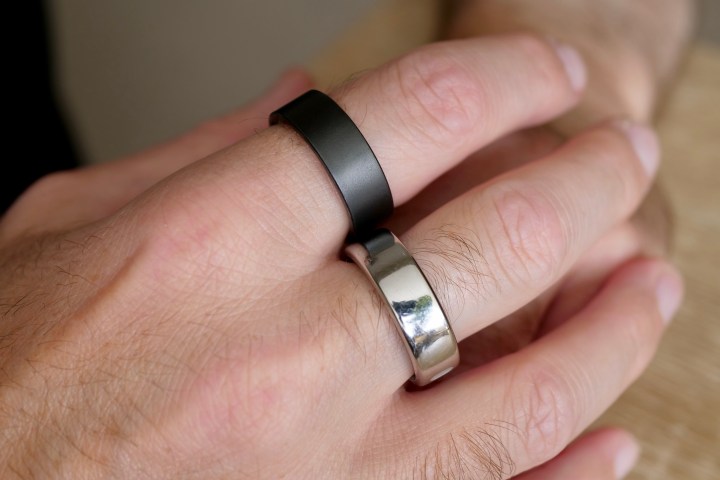
I love the concept of the smart ring. It’s so inconspicuous, yet can still be stylish and work as a fashion statement. And they are immensely easy to wear because they don’t get in the way. What’s more, I can wear my favorite watches on my wrist and still track my movement, exercise, and sleep. I’ve enjoyed the Oura Ring for more than 18 months, but have recently spent more than a month with the Ultrahuman Ring Air, which is quite a different beast.
Which one is better? This is a very difficult question to answer, as despite both fitting on your finger, they work and inform in different ways. If you’re stuck on knowing which one to buy, I don’t blame you, so here’s advice from someone who has worn both for some time.
Which smart ring is more comfortable?
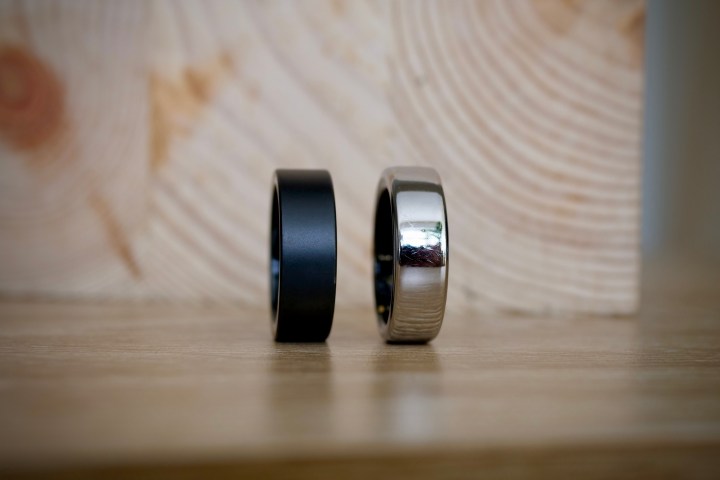
The question about which smart ring is more comfortable is perhaps the easiest one to answer. The Oura Ring is more comfortable to wear than the Ultrahuman Ring Air, and it’s due to its softer edges, careful curves, and minutely thinner body. You wouldn’t think less than a millimeter would make any difference, but you actually can feel the tiny differences between the Ultrahuman and Oura rings on your finger.
To clarify, though, the Ultrahuman Ring Air isn’t uncomfortable — it’s just a touch more noticeable. The squared-off edges and minuscule increase in width meant I knew the ring was there, while the Oura Ring’s tapered edges reduce this feeling. Both rings are still thicker and wider than a non-smart ring, so you will always feel it to a certain extent, but the Oura Ring is less unnatural.
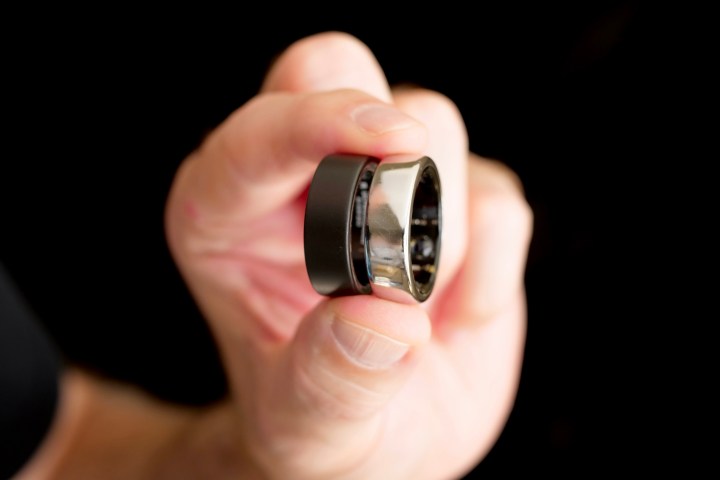
After wearing the Ultrahuman Ring Air for a month and performing normal activities — including washing cars, working out, and playing golf — I’ve noticed it has begun to slightly rub the pad at the base of my finger, where it presses as my hand closes. It doesn’t hurt, but it appears a callus may form. After 18 months with the Oura Ring on the same finger, this has not occurred, and the skin has clearly not been rubbed at all, so it seems most likely it’s due to the Ultrahuman Ring Air and its lack of curves.
Returning to the Oura Ring after weeks of wearing the Ultrahuman Ring Air did make me notice something I hadn’t considered, and that’s the way the rings ensure the sensors connect with your finger. The Oura Ring uses three tiny nubbins, and I actually felt them more when I put the ring back on, while the Ultrahuman Ring Air has a raised, but flat section on the underside that I never felt that at all. After wearing both rings for a day or so, you don’t notice this aspect, though.
Which smart ring has the better design?
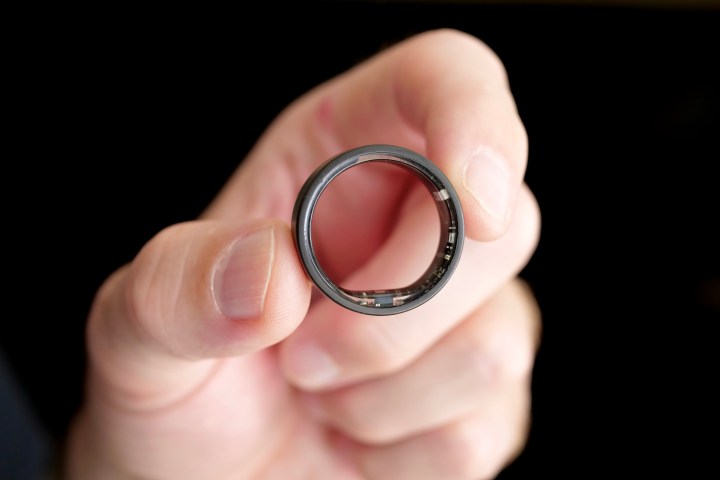
There are two different Oura Ring designs: the circular Horizon model and the Heritage, which has a flat “plateau” section to give it a classic, characterful look. Each is available in silver, black, Stealth (which is matte black), and gold finishes, while the Horizon also comes in Rose Gold. The Oura Ring is made from titanium with a hypoallergenic inner section. I’ve worn the Stealth, black, and silver versions over several years and have found the polished black version the least likely to show any marks the surface collects, though I personally prefer the beautiful polished silver.
The Ultrahuman Ring Air comes in either Matte Black or a polished Aster Black. I’ve worn the Matte Black version, and it has picked up a few small marks over the last month, but nothing that detracts from its appearance. I had the same experience with the Stealth version of the Oura Ring. It’s also made from titanium with a hypoallergenic inner section. The black finish is definitely quite masculine, and when you choose the black version of either ring, it’s very noticeable when worn on its own.
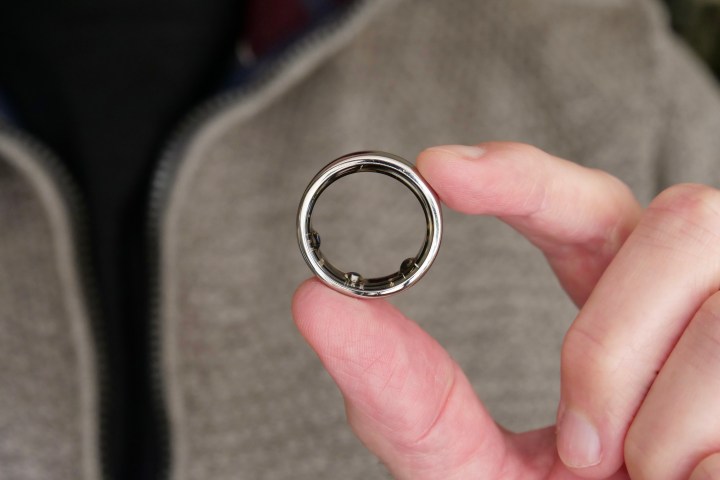
Ultrahuman is still quite new to the smart ring world, so it’s not that surprising it doesn’t have multiple finishes or designs to choose from yet. It is working toward providing more choice, though, and the Aster Black version became available during my review period. The company told me in an email: “We have experimented and run extensive R&D on colors that are durable, as well as aesthetically appealing. The next color on the horizon is a mirror finish silver that’s exquisite, but minimal, maintaining the unobtrusive form of the Ultrahuman Ring Air.”
Currently, the Oura Ring provides more choices, but Ultrahuman is catching up. However, there is an important distinction here, as a smart ring shouldn’t just be about color choice – it should also be about whether it looks and feels like a piece of jewelry. It’s the Oura Ring that succeeds here due to the subtler, refined, and curvier shape.

What’s interesting to me, though, is that the Ultrahuman Ring Air looks and feels more futuristic and less dainty than the Oura Ring can look, depending on the color you choose. Based on one’s own personal style, I can see how the Ultrahuman Ring Air could appeal more. Most importantly, the Oura Ring is superbly made, and all the versions I’ve worn have been immensely durable. During my month with the Ultrahuman Ring Air, it looks to be equally as well made and durable.
Which is better to track activity?
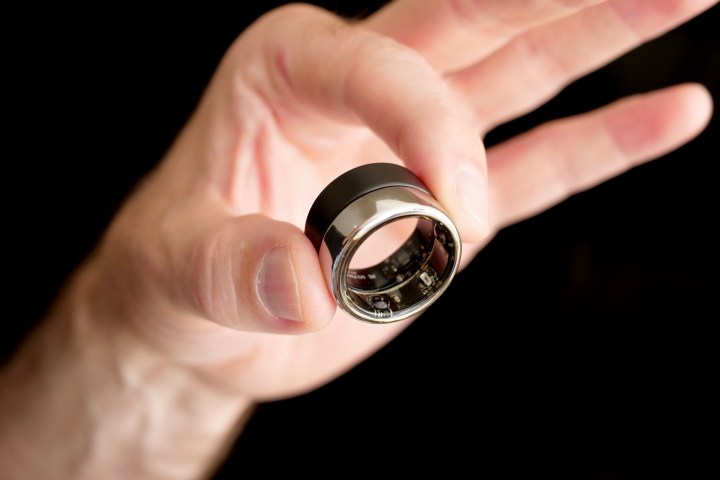
Both smart rings excel at tracking sleep. They have similar sensor arrays and provide very similar data, and often even return the same Sleep Index score. I have noted the Ultrahuman Ring Air often has a higher average heart rate than the Oura Ring, but as neither are medical devices, deviations are expected, and neither are guaranteed to be entirely accurate. Regardless of which one you choose, sleep tracking is informative and useful.
The Ultrahuman Ring Air tracks a lot more exercises than the Oura Ring, including basic strength workouts, tennis, yoga, basketball, and football. However, the Oura Ring automatically picks up and logs when you walk or run, then adds it to your daily activity. It’s all part of Oura’s less fitness-focused and more convenient hands-off nature. The Ultrahuman Ring Air is the more effective fitness tracker, but it does require a lot of input on your behalf. The Oura Ring is more passive, but less capable.
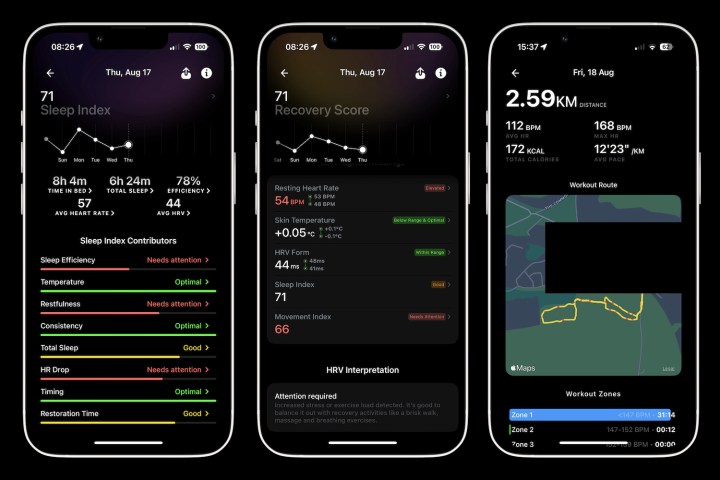
The Oura Ring better suits my life when it comes to activity tracking and reporting. I love the big, easy-to-understand figures in the app and the way I can ignore calorie burn if I want. I have to dig into the Ultrahuman app more, and when I do, the data isn’t as easy to interpret at a glance. The ability to set my own daily goals also makes it more motivational than the Ultrahuman Ring Air’s automatically assigned goals.
I used both smart rings to track a simple outdoor walking exercise. The Ultrahuman Ring Air recorded a higher heart rate, with the maximum appearing to be highly unrealistic, and therefore, in turn, recorded a far higher calorie burn than the Oura Ring. I also tracked the same activity with the Mobvoi Ticwatch Pro 5, and it returned a similar average heart rate to the Oura Ring, but a calorie burn closer to the Ultrahuman Ring Air.
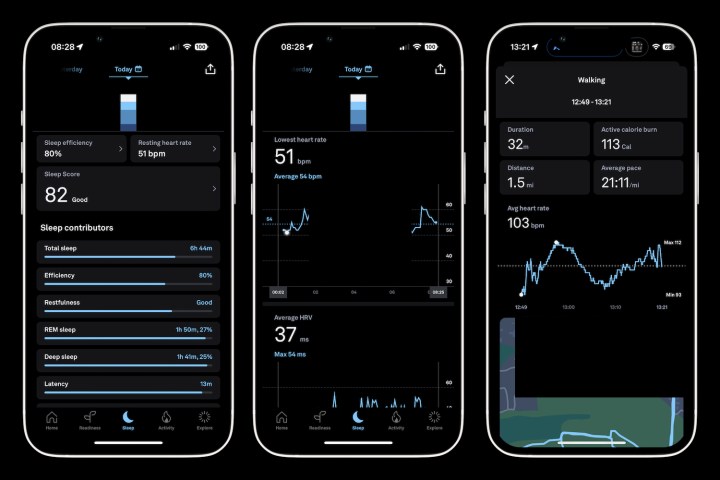
The Ultrahuman Ring Air definitely provides more fitness-tracking options than the Oura Ring, but I can’t help feeling that if you want to track anything more in-depth than walking, running, or a simple gym workout, a full smartwatch would be more beneficial.
Which one is a better value for the money?

Yes, the Oura Ring charges a monthly subscription, and the Ultrahuman Ring Air does not. But let’s forget the money for a moment, as there are a few features that add considerable value to the Oura experience. Its integration with the Natural Cycles fertility app is a very big deal, and although it’s not relevant to me personally, I’ve heard from other wearers that pairing the Ring with the app is transformational. Oura also has a partnership with Therabody and recently introduced an unusual social feature called Circles.
These are not part of the Ultrahuman Ring Air, but the two rings do provide access to different mediations, guided relaxation sessions, and other audio content. While Ultrahuman’s app has more content, I personally find that the Oura Ring’s sessions suit me better. They’re less time-intensive and less “out there” than some of the sessions in the Ultrahuman Ring Air’s app, and crucially, they work with its sensors to give you feedback after the session is complete. I can actually see if the Oura Ring’s sessions relaxed me or not, as I have evidence to back up the way I feel.
The Oura Ring charges a monthly subscription, and the Ultrahuman Ring Air does not.
That’s before we talk about the app itself, where Oura’s is better designed, more attractive, less confusing, and more logically ordered than the Ultrahuman app. I understand what it tells me and can see how its advice would fit into my life, while the Ultrahuman’s app requires a lot more investigation, and even then, I sometimes have no idea why I should pay attention to what it tells me. Both apps are fast and reliable, and the connection between them and the smart rings has been faultless.
You pay $6 per month for the pleasure of seeing all the Oura Ring’s data and using its features, but when compared to the free experience provided by the Ultrahuman, it’s clear where at least some of the money goes. No one wants to pay a subscription, and certainly not after spending at least $300 on the product itself, but there is a considerable amount of value with the Oura Ring that’s missing from the Ultrahuman Ring Air. The rings themselves cost around the same, with the Oura Ring ranging from $299 to $549 (my preferred polished silver model is $349), while the Ultrahuman Ring Air costs $349 regardless of the finish.
Which smart ring is the one for you?
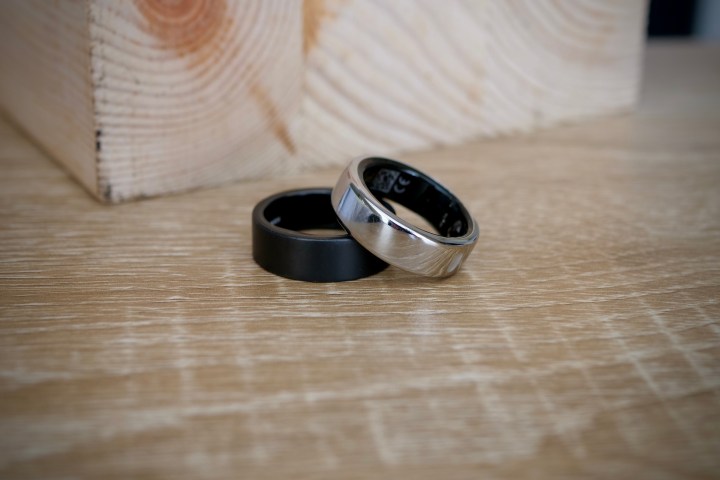
How do you decide? A key point that helped me understand the two smart rings is that the Oura Ring is more personal than the Ultrahuman Ring Air. It’s a very hard thing to describe without sounding like a fool, but the Oura Ring is fluffier, while the Ultrahuman Ring Air is harder. From the design and colors to the language used in the app, the Oura Ring is a much friendlier product than the Ultrahuman Ring Air.
While training hard isn’t my thing, if it’s yours, then the Ultrahuman Ring Air will be the one to choose, as the Oura Ring’s softly-softly approach and focus on lifestyle won’t be enough to motivate you, and the more delicate styling may not match your personal look either. I want to track my sleep, movement, and some basic exercise, plus I want at-a-glance data on it all. I also want a comfortable, beautiful product, and the Oura Ring ticks all those boxes.
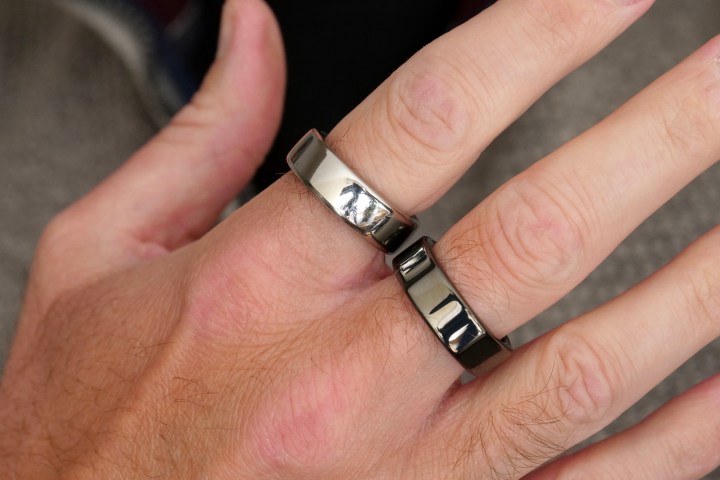
I personally don’t feel as “close” to the Ultrahuman Ring Air due to its harder edge, unique language and descriptions, and emphasis on performance, but I understand this won’t matter to everyone. Both are pieces of technology, it’s just that the Oura Ring disguises it more than the Ultrahuman Ring Air. If I’m going to wear a piece of tech on my body, it needs to have “something” about it.
The Oura Ring is my personal choice, but the great thing is, if the Oura Ring isn’t quite focused or hardcore enough for you, the Ultrahuman Ring Air does pick up some of the slack. It’s not a Garmin Forerunner 265, but it’s a lot closer to one than the Oura Ring. If the Garmin is too fitness-focused, I still believe the Oura Ring paired with an Apple Watch is a fantastic combination that will suit almost everyone’s needs.
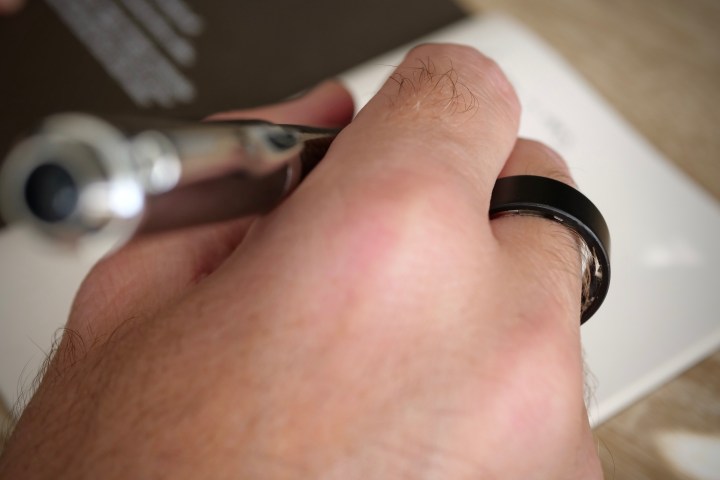
Here are two products that suit two different types of people, and provided you choose correctly, I think you’ll be happy with your purchase. Over the last few months, I’ve learned that I’m an Oura Ring person, but happily, I’ve also learned that if I wasn’t, there’s still a smart ring available that would probably suit me.
Editors’ Recommendations
Services Marketplace – Listings, Bookings & Reviews
